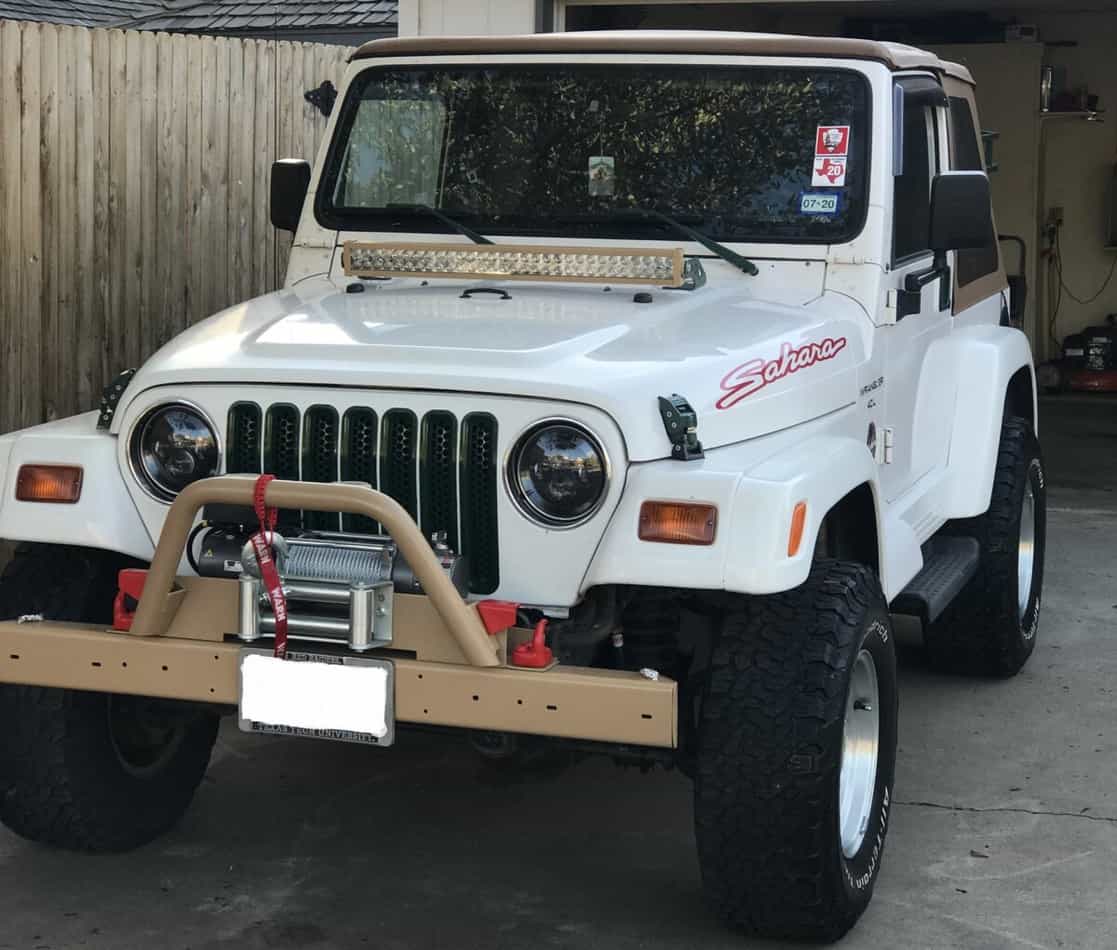Owning a Jeep is sort of like a gateway into the world of DIY (Do It Yourself). It might not start that way, in fact you may have no intention of ever working on it when you buy it, but something about being a Jeep owner just leads you down the path of “I bet I can just do that myself”. I think it started as a way to save money but then I started enjoying it. Regardless, after several years, servicing and working on my Jeep is just second nature.
How do you service a Jeep Wrangler? In short, common things that need to be looked at in a Jeep Wrangler servicing are as follows:
- Engine Oil
- Fluid Levels
- Tire pressure, tread quality, and rotation
- Interior and Exterior Light Functionality
- Brake System
- Battery
- Cooling System
- Exhaust System
- Air Filter
- Suspension/Steering
- Spark Plugs
- PCV/CCV Valves
- Sensors
Fortunately, not every one of these components needs to be checked at every service. By all means, if you have the time, then this thorough of an inspection at every service would be fantastic. However, I am going to outline below which systems need to be checked at which service intervals and outline what that process might look like.
How Often Should You Service Your Jeep Wrangler?
The frequency of servicing your Wrangler (or any vehicle) is very dependent on how much you use it and in what kind of conditions. Not everyone goes rock crawling every weekend and we know for a fact not everyone strictly drives on the pavement in perfectly dustless conditions. And while many people follow a very strict and to the “T” service schedule, others play things by ear and are pretty flexible on when things get done.
The one thing that sparks a lot of debate is how often you should change your oil. While the dealership and servicing centers like to get you in there as frequently as they can, it might not always be necessary. On the opposite end of the spectrum, it’s definitely not recommended to wait every other year or so before changing it.
The best thing to keep your vehicle in great condition is to be consistent and thorough. For your specific vehicle, there is almost always a recommended maintenance schedule in the back of your owner’s manual. Because of the vast number of Jeeps on the market and the varying components in each (especially considering how modified Jeeps can get), it’s near impossible to layout a great schedule to follow for everyone. I encourage you to check your owner’s manual for recommended schedules then follow that or modify it based on your driving habits and conditions and vehicle-specific components.
Rather than lay out a detailed schedule for maintenance, the 13 steps below will walk you through specific components and how often you should check each and what that process looks like. Let’s dive in.
1. Engine Oil
When it comes to the engine oil and the question of how often you should change it, there are many many different opinions. My personal opinion is you should not exceed, maximum, 10,000 miles between oil changes (or about 9 months). On the other hand, it’s also pretty unlikely that you need to change it every 3,000 like is often recommended by dealerships and service centers. The frequency you change your oil is so specific to where you drive and how you drive.
If you find yourself out on the trails or dirt roads a lot, you probably should consider changing your oil more frequently as dust, dirt, and grime can be brought in through your air filter and get into your engine. But if you drive mostly city or don’t drive often, you are probably fine to push your oil changing intervals a bit further apart.
While I won’t get into the science and theory behind Synthetic and Conventional here, the type of oil you decide to run can also play a role in how often you do an oil change.
Luckily, I already have a detailed article on How to Change Your Oil if you follow the link. You’ll find everything you need on how to properly change your oil, types of oil (synthetic/conventional), and more.
2. Fluid Levels
Fluid levels seem/is a very ambiguous term when you pop your hood and are staring at an engine bay. “Check the fluid levels they said. What fluids are they talking about??”
So, what fluid levels should you check in your Jeep? Below is a list of fluids that are easily able to be checked and a couple that might take some work.
- Radiator Fluid/Engine Coolant
- Brake Fluid
- Power Steering Fluid
- Washer Fluid
- Transfer Case Fluid
- Transmission Fluid
Most of the time, checking these fluids doesn’t require anything more than topping them off or checking to ensure they are already at proper levels. However, check your service manual to see what mileage it recommends some of these be completely replaced. For instance, transmission fluid and transfer case fluid, argued by many, shouldn’t be changed unless absolutely necessary. The reason being, there’s not a lot of reasons why those should be bad.
But, if you are checking those fluids regularly, you are opening up the system to outside dirt and objects. So, be sparing when you open up the transfer case or transmission fluid fill ports. If you don’t have to, it might be best to leave it alone until the manual suggests replacing the fluid. Or, obviously, if something goes wrong causing you to need to change it.
Check out these videos on changing transfer case fluid and transmission fluid. While they are being done on an older Wrangler, the concept is similar to newer Jeeps.
Fortunately, the other fluids mentioned are able to be checked just by opening the hood. When you look into your Engine bay, you can quickly spot several caps and “lids”. These are a few of the areas to check your fluids. Most of the time, your fluids need to be checked on a cool engine that has had plenty of time to reach ambient temperature after running.
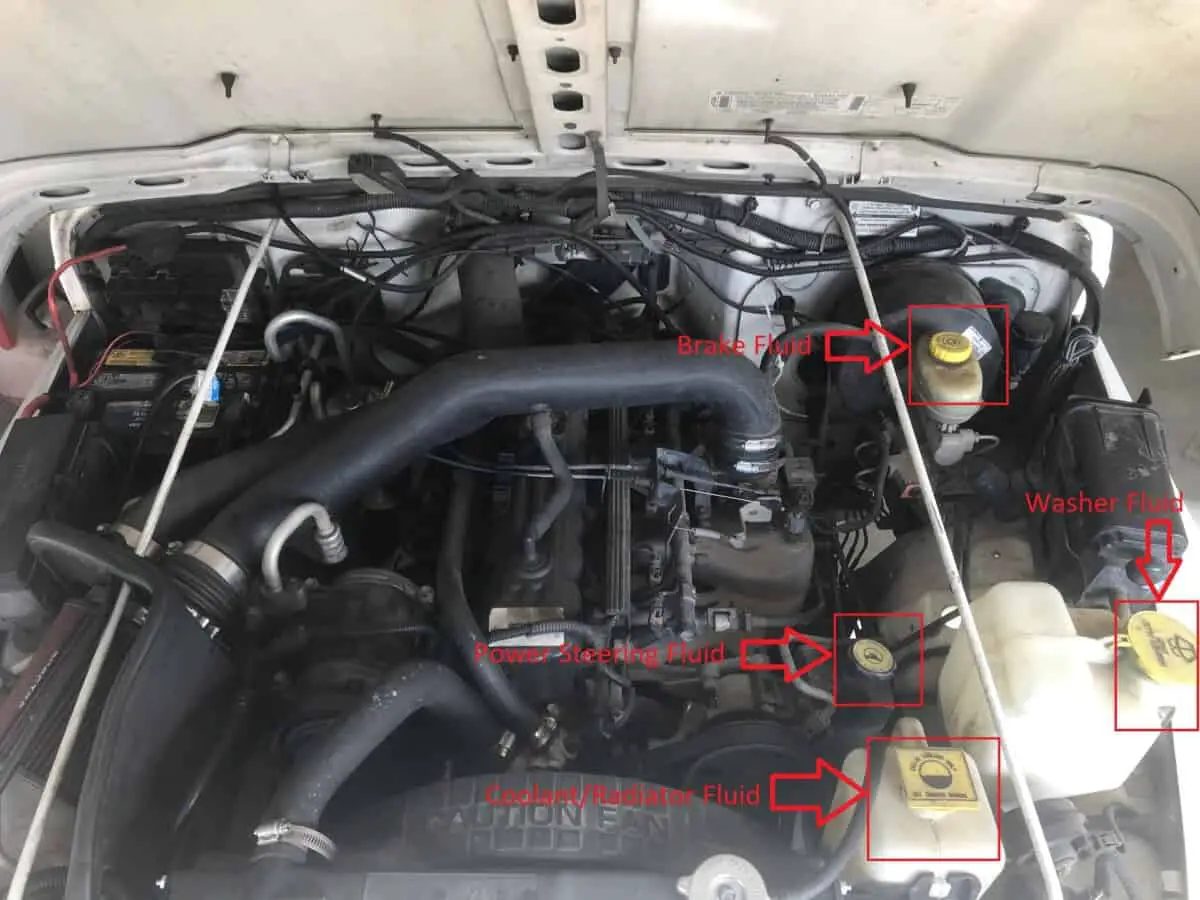
When you refer to your owners manual, you’ll find out where these fluids need to be. However, most containers have a fill line on them for quick reference.
- Washer Fluid
- Simple and Easy: go to any gas station, Walmart, or Auto Center and get a jug of washer fluid. There are a few choices and most of the time it’s just personal preference. If you live in extreme weather conditions, they will probably offer one suitable for your region.
- Next, find the cap that specifies it is for washer fluid and just poor in the fluid till it reaches the fill line. That’s it.
- Radiator Fluid
- It is EXTREMELY important to make sure your car has cooled off before checking the radiator fluid.
- Older cars usually have a radiator reservoir that you simply add the appropriate coolant (check owners manual) to up to the fill line. It’s usually good to unscrew the radiator cap also and just make sure the fluid is right up at the top.
- If you have a radiator leak or have done a system flush, you’ll usually have to add fluid directly to the radiator before filling the reservoir tank.
- Newer Cars often don’t have a separate tank or direct access to fill the radiator. Rather, they have a pressurized tank. The tank looks similar to a reservoir and also has a fill line. On these types, you only have to ensure the fluid is up to the fill line as this is your only access to the radiator.
- Brake Fluid
- Unless you’ve done a brake line bleed or other work to your brakes, checking your brake fluid is as simple as ensuring it’s at the fill line. Close to the Master Cylinder is usually an easily accessible screw cap to add fluid too.
- Power Steering Fluid
- This fluid can be checked whether hot or cold as there are indications on the dipstick for both hot and cold temperatures. Just make sure your engine is off.
- Similar to brake fluid, as long as you didn’t just service or flush your power steering system, simply add the appropriate (check manual) fluid to the fill indication and secure the cap.
3. Tires: Pressure, Tread, & Rotation
- Pressure
- Tire pressures range for each owner and Jeep. Typically, the correct pressure ranges from 25 psi to 60 psi. You can check your manual for recommended tire pressure. The downside to this is it all depends on the size and types of tires you have. “Airing down” is a very common practice when off-roading in which you let the air out of your tires to very low pressures. However, when on road, you want to ensure proper inflation for gas mileage, braking, wear, and other safety factors.
- My best suggestion for figuring out what tire pressure you should run is to spend an hour or so looking through the prominent Jeep forums for people running your tires and Jeep setup. You’ll quickly figure out who to listen to. There is no simple calculator that will spit out the right numbers for everyone. Each tire and setup requires you to find the right pressure for you. And relying on the tire shop to fill it properly isn’t the route to go either as they often do it incorrectly.
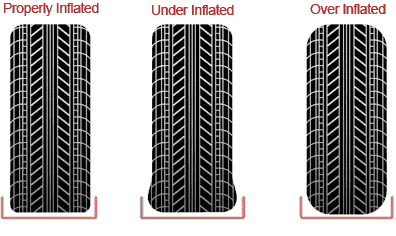
- Tread Depth
- Luckily, checking the tread depth of your tire is relatively universal and easy. Simply take a penny and with it upside down, put it into a section of your tread. If you can see all of Lincoln’s head, your tread is too low.
- For the more sophisticated, your tread needs to measure above 2/32 of an inch. If you have a better way to measure this, go for it. The Penny Test is quick and simple and can be done with no special tools.
- Rotation
- The last thing to consider when servicing your Jeep is if it is time for a tire rotation. Tires should usually be rotated every 6,000 – 8,000 miles or every six months.
- Most manuals provide a recommended rotation pattern but you can use the below image as a guide. What you should consider is if you are doing a 4 tire rotation or 5 tire rotation which rotates your spare into the mix.
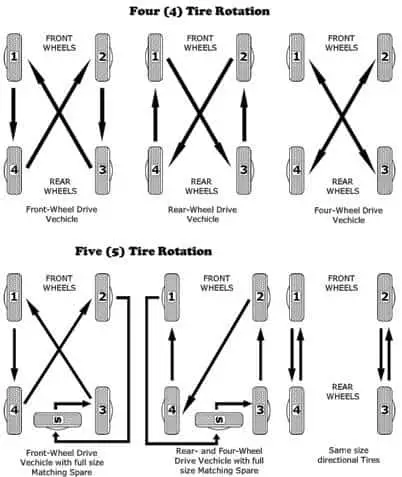
- If you are rotating your own tires, ALWAYS ENSURE THE LUG NUTS ARE PROPERLY TORQUED PER FACTORY SPECS BEFORE DRIVING.
4. Light Functionality
Checking your lights is a pretty simple process and should be done anytime you’re doing a service on your vehicle. Doing so ensures you have properly working bulbs in your headlights, indicators, and reverse. For Jeep owners, you might have several other lights to check as adding light bars and extra spotlights are very common.
While checking lights by yourself certainly can be done, having someone help you by sitting in the vehicle to turn lights on and off or press the brakes definitely is a plus.
The video below walks you through a simple process to check your lights. In these scenarios, having a visual aid of what to look for often is better than just reading the words.
5. Brake System
The next thing you want to consistently check and inspect is your brakes. It goes without saying that properly functioning brakes are imperative for safe operations both on and off-road. Follow the checklist below to give your brakes a good inspection and to monitor parts as they wear.
- Take your Jeep for a drive. Pay special attention to any grinding sounds, weird smells, the vehicle pulling when applying brakes, or brakes simply not working like they use to. If you have already noticed problems with your brakes, be extremely careful while you do this. It is probably best to be in a secluded area and not where you can damage other vehicles.
- Visually Inspect Your Brake System Components. As you do this, you want to pay close attention to visible cracks in things like hoses or cases. Watch for any liquids running down components or dripping under the car and follow them to the source.
- Check Brake Fluid. Beyond just checking the level of your brake fluid, you want to make sure your fluid is still in good condition. You can either visually inspect it and make sure it is the proper color and consistency or buy a PH testing kit that will let you know. If you need to, replace your brake fluid by doing a proper system flush. Make sure you replace your fluid with the recommended brake fluid found in your manual or online.
- Remove wheel and inspect brake components. Whether your Jeep has disc brakes, drum brakes, or both, you want to be able to check the components of the brake (i.e. pads, calipers, rotors, etc.). If you notice dripping fluids, rust, or worn-out components, you need to address the issue. Your brake pads should have at least 1/8″ or more of the pad on them.
- Repair or Replace Parts as Necessary. Brake components usually aren’t terribly expensive when you just need one or two certain pieces. Brake drum rebuild kits can be found for around $100 and allow you to replace all the parts inside the drum. With a little patience, brake work can be done by yourself in an afternoon or evening.
6. Battery
I usually check my battery for obvious signs of issues anytime I open the hood. Do I have to? No. But it’s convenient and easy to just give it a quick look over and make sure things look in order.
When you check your battery, the most obvious sign of needed maintenance is corrosion around the terminals. Most of the time you can get a small wire brush and just scrape it off. If needed, use some kind of acidic cleaner to help dissolve the corrosion (vinegar is a good go-to). If you do find yourself needing to clean it, make sure to disconnect the battery.
After your terminals are clean, make sure your clamps are on tight and not wiggling around. Loose connections can cause all sorts of issues. Jeeps tend to use more accessories than some vehicles and therefore you may have more things connected to your battery. It’s important to check all connections. Lots of Jeep users end up upgrading factory clamps to heavy-duty marine ones because of all the off-road mess we find ourselves in.
If your connections are solid and terminals clean and you haven’t had any specific issues, this is usually all you need to do to inspect your battery.
If you think something further is going on or are just curious, you can drive to your local auto stores like Auto Zone or O’Reilly and have them perform a test on your battery to get a health report. This will tell you the actual state of your battery and allow you to plan when you need to replace it.
7. Cooling System
A well maintained cooling system is essential to keep your engine running in its optimal state as designed by the factory. For your Jeep Wrangler, the cooling system consists of:
- Radiator
- Water Pump
- Upper/Lower Radiator Hoses
- Fan Clutch
- Radiator Cap
As with a lot of the components in these 13 steps, not everything above needs to be serviced every time. In older Jeeps, you usually want to flush your radiator every 2 years or 30,000 miles. However, on newer models, your service interval can be as much as 100,000 miles.
It’s not a bad idea of just checking the fluid when you are under the hood. Get familiar with what it should look like fresh, and if it isn’t looking clean, consider flushing it. As simple a thing as coolant can be quite scientific. While older models use ‘the green stuff’ (green colored coolant) many newer models use new and improved ‘red stuff’ or ‘orange stuff’ or whatever color it is now.
It’s very important you know what kind of coolant your engine needs. As always, CHECK THE MANUAL. It will tell you.
If you aren’t aware of when the last time each component was replaced, it’s not a bad idea to do it yourself and set the benchmark. I strongly recommend you not buy aftermarket “performance” parts here. Use what was designed by the manufacturer. From there, you can at least expect 10 years or more before needing to replace the main components.
Overhauling a cooling system isn’t hard, it just takes some patience. Always drain your system completely to get all the old coolant out. This often takes several gallons of water run through the system to get it really flushed.
After flushing the system with clean water, take the opportunity to replace hoses and the proper thermostat. Your engine cooling system is designed to work in unity with each part. The proper thermostat is 100% necessary. Don’t try buying a lower degree thermostat thinking it will help your engine run better. Use what is installed from the factory.
After putting the new parts in, and securing everything, you want to flush your system more. However, this time with DISTILLED water. This will make sure you don’t leave behind minerals found in non-distilled water.
Some people will use hose water at first to get the main stuff out, then use distilled. However, I recommend just using distilled from the start. It’s cheap.
Lastly, with your proper coolant recommendation, fill your system. Make sure to properly ‘burp’ the system (if required) and get any air out. This process looks different for different vehicles and some (like the Jeep TJ) are designed to self burp. Check to see what your specific system needs just to make sure.
8. Exhaust System
This is usually a quick and easy step. All you want to do here is check your exhaust component for cracks or damage. If you are hearing abnormally loud noises in your exhaust, check your manifold and pipes for cracks. If you live somewhere with strict emissions regulations, make sure your necessary emissions components are functioning and not damaged.
As you get your car inspected yearly, if you have failing emissions, they’ll let you know what needs fixing. With the other components, you should be fine unless you are just wanting upgrades. Most exhaust components don’t require regular maintenance.
9. Air Filter
A clean air filter makes sure that the air coming into your engine isn’t full of dirt and particles that will get trapped inside and cause long term issues.
There are two types of air filters you can get. One is a paper filter that is thrown away each time your service it and replaced with a new drop-in one. Many argue that these filters are better and easier.
The other kind of air filter is one that is cleaned and oiled with a special kit. You clean the filter with water and the cleaning agent then use the filter oil to re-oil it. These filters are more ‘eco-friendly’ because they don’t get just thrown away and you usually don’t have to service them as often as you would need to replace a paper filter.
I have experience with both air filters, and unfortunately, I can’t say definitively which way you should go. I will say that paper filters are easy and have a better case for them and are as high-efficient as you could hope for. You don’t have to do anything other than switch it out.
Replacing your air filter usually just means opening your intake box and taking the old old filter out that sits there and putting the new one in. Paper filters should be replaced 15,000 – 20,000 miles. Reusable filters should be cleaned about every 50,000 miles (under normal conditions) according to K&N.
10. Suspension/Steering
In the Jeep world, the suspension and steering components are different on almost every Jeep because they are some of the first things to get upgraded or replaced when a Jeep is lifted. Below is a picture of the front end of a Jeep Wrangler TJ:

I inspect my steering and suspension components almost every time I go off-roading or when I get back. It’s never a bad idea to give them a good look over every oil change.
Things you want to do when checking these pieces include making sure nuts/bolts are torqued and tightened properly, grease any greasable components likes bushings, tie-rod ends, sway bar links, etc, and check for broken/breaking welds or worn out parts.
A valuable tool to have is a good grease gun. Many aftermarket parts like control arms, sway bar links and many others, come with ports that allow you to grease and lubricate those parts to make sure they don’t wear prematurely and also keep things from squeaking.
As you inspect these parts, you want to make sure there is no lateral or vertical loose play in the joints. If so, go ahead and replace the culprit.
Loose components in these areas can lead to some dangerous situations like death wobble or similar. So take the extra safety precaution and inspect these whenever you can.
11. Spark Plugs
When you think of giving your car, lawnmower, or other motorized tools a good tune-up, you probably include changing out the spark plugs.
There’s a good chance that the older the car you have, the easier it will be to do this. Reason is there is more room in the engine bay. New cars tend to be more compact and may require remving some stuff ot accesss them.
Replacing spark plugs usually can usually be done every 80,000 – 100,000 miles on Jeep Wranglers.
When you replace the plugs, while it’s not necessary, it’s not a bad idea to replace the spark plug wires and if applicable, the distributor cap. Many times, these items come together in a tune-up kit available online.
Beyond the varying degree of difficulty reaching the spark plugs, the act of replacing them is pretty straight forward. Using an appropriate sized spark plug socket, unscrew the old one and put the new one in. Snap the wire back on and you’re good to go.
When choosing replacement plugs, you get what you pay for usually. If you go cheap you can expect to replace them more often. I personally (with much research and more knowledgeable people than myself) recommend spending a little extra and using iridium spark plugs which usually will last well beyond 100,000 miles.
12. PCV/CCV Valves
PCV (Positive Crankcase Ventilation) and CCV (Closed Crankcase Ventilation) valves usually are positioned on top of the engine crankcase and are responsible for dispersing unwanted gases from the system and allowing for fresh air into the system.
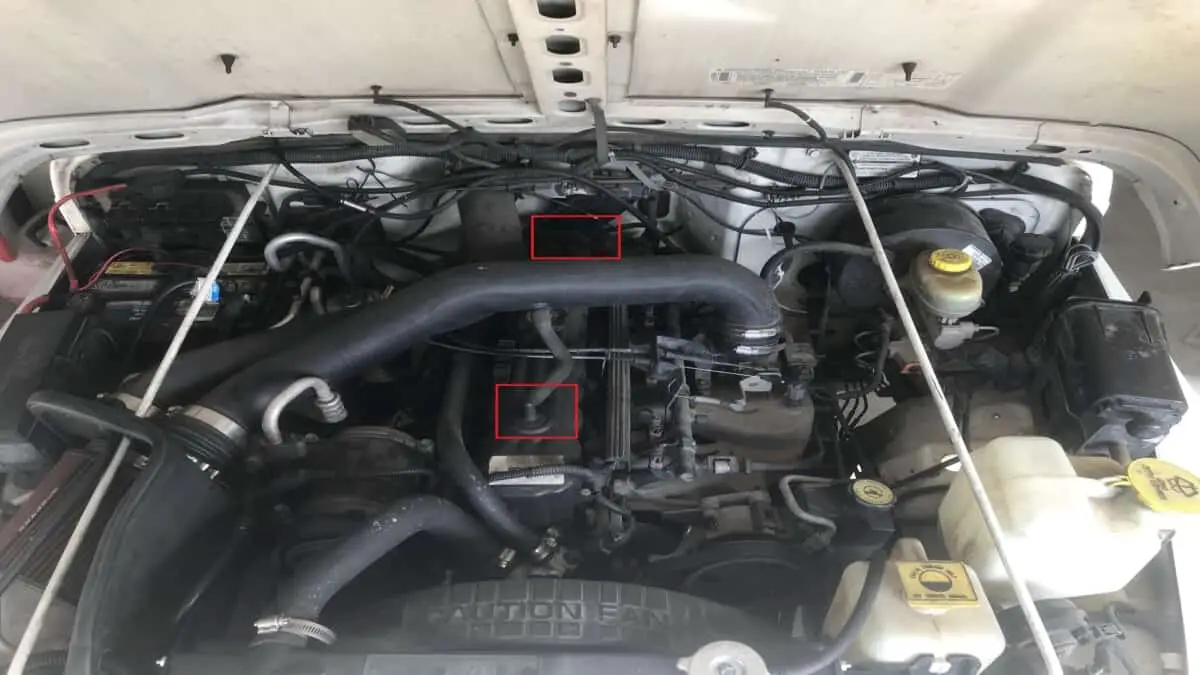
While regular maintenance might not be necessary, if you notice abnormally poor engine performance or sluggishness, these valves are good to check. Make sure they are clean and have a good flow.
Replacing these valves is straightforward but can become a problem if you aren’t careful. Due to the brittle plastic construction, use extreme caution when removing them to prevent snapping or breaking and losing pieces into the engine. By replacing these pieces more frequently (i.e. every 30,000 miles) you might avoid them becoming brittle and difficult to remove.
13. Sensors
Most vehicles these days have more sensors than you can count. As cars get smarter and smarter, there are more computer components involved that take input from various different sensors.
Most of the time, you don’t want and don’t need to replace sensors unless you have a clear problem or your dash is showing some error code. If you aren’t able to retrieve the error code yourself, you can drive to an auto-store and they will be able to tell you exactly which sensor needs replacing.
In the world of Jeeps specifically ( I can’t speak on other vehicles), your best bet is to always use factory/OEM sensors when replacing bad or worn-out ones. From personal experience, I can tell you I had to replace my TPS (throttle position sensor) every 4 months when I used a local auto store brand. While it had a lifetime warranty (meaning I never paid for the new sensors), I still had to constantly think about that sensor failing and replacing it. Finally, I paid the extra money for the Mopar (OEM for Jeep) sensor and haven’t had an issue for 2 years. Your vehicle’s computer is made to interact with specific components, and sensors are no different. Use what was designed for your vehicle and you’ll usually always have your best performance.
Conclusion
Each vehicle has it’s own needs and requirements. As you get more familiar and comfortable working on yours, you’ll learn what things you have to watch for and pay attention to more frequently. The above list gives you some basic things to keep well maintained but it is not complete. Take the time to learn your specific setup and research online to learn from others with years of experience.
If you have questions on how to replace/work on specific Jeep Wrangler components, keep your eye out on our growing “how-to” sections as we will continue to add guides and instructions.
Your vehicle should be reliable and be able to get you where you need and back. Part of making sure that happens is good and regular maintenance. Set up a routine for yourself to service your Jeep and we know that you’ll be set to keep the Wilderness on YOUR Side.

